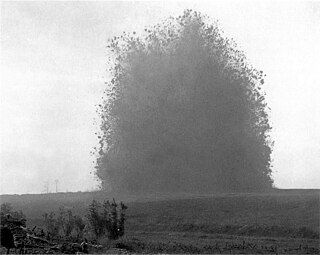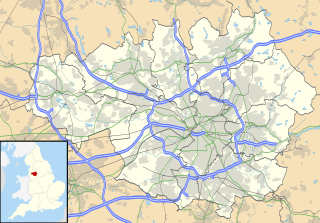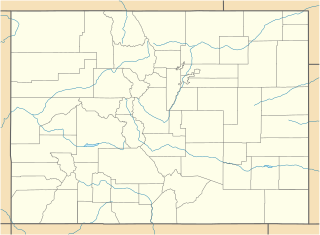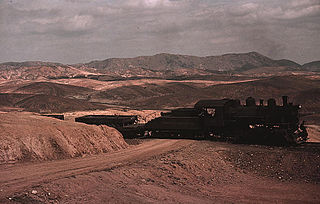
Risca is a town in the Caerphilly County Borough and the historic boundaries of Monmouthshire in south-east Wales. Risca has a railway station, opened on the Ebbw Valley Railway in February 2008, after a gap of 46 years. It is split into two communities; Risca East and Risca West. It has a population of 11,700.
A mining accident is an accident that occurs during the process of mining minerals or metals. Thousands of miners die from mining accidents each year, especially from underground coal mining, although accidents also occur in hard rock mining. Coal mining is considered much more hazardous than hard rock mining due to flat-lying rock strata, generally incompetent rock, the presence of methane gas, and coal dust. Most of the deaths these days occur in developing countries, and rural parts of developed countries where safety measures are not practiced as fully.

There have been many extremely large explosions, accidental and intentional, caused by modern high explosives, boiling liquid expanding vapour explosions (BLEVEs), older explosives such as gunpowder, volatile petroleum-based fuels such as gasoline, and other chemical reactions. This list contains the largest known examples, sorted by date. An unambiguous ranking in order of severity is not possible; a 1994 study by historian Jay White of 130 large explosions suggested that they need to be ranked by an overall effect of power, quantity, radius, loss of life and property destruction, but concluded that such rankings are difficult to assess.

The Oaks Colliery explosion was a British mining disaster which occurred on 12 December 1866, killing 361 miners and rescuers at the Oaks Colliery at Hoyle Mill near Stairfoot in Barnsley, West Riding of Yorkshire. The disaster centred upon a series of explosions caused by firedamp, which ripped through the underground workings. It is the worst mining accident in England and the second worst mining disaster in the United Kingdom, after the Senghenydd colliery disaster in Wales.

Mining in Australia has long been a significant primary sector industry and contributor to the Australian economy by providing export income, royalty payments and employment. Historically, mining booms have also encouraged population growth via immigration to Australia, particularly the gold rushes of the 1850s. Many different ores, gems and minerals have been mined in the past and a wide variety are still mined throughout the country.

Clifton Hall Colliery was one of two coal mines in Clifton on the Manchester Coalfield, historically in Lancashire which was incorporated into the City of Salford in Greater Manchester, England in 1974. Clifton Hall was notorious for an explosion in 1885 which killed around 178 men and boys.

Kiveton Park Colliery was a coal mine in the village of Kiveton Park, near Rotherham, South Yorkshire, England.
The Hurricane Creek mine disaster occurred on December 30, 1970, shortly after noon, and resulted in the deaths of 39 men. As was often pointed out in coverage of the disaster, it occurred a year to the day after the passage of the Coal Mine Safety and Health Act of 1969. Recovery was complicated by the fact that a foot of snow fell on the rural mountain roads at the time of the accident.

The Brunner Mine disaster happened at 9:30 am on Thursday 26 March 1896, when an explosion deep in the Brunner Mine, in the West Coast region of New Zealand, killed all 65 miners below ground. The Brunner Mine disaster is the deadliest mining disaster in New Zealand’s history.

Mining in New Zealand began when the Māori quarried rock such as argillite in times prior to European colonisation. Mining by Europeans began in the latter half of the 19th century.

Aldridge is a ghost town in Park County, Montana, United States. According to the book Ghost Towns of the Montana Prairie, the town was incorporated as Aldridge in 1906 but was earlier named Horr, and later Electric. Aldridge is a mining town that supplied coke and coal to the smelters for the Anaconda Copper Mining Company. Aldridge is located two miles north of the northern entrance to Yellowstone National Park.
Pentremawr Colliery was a coal mine, located in the Gwendraeth valley in Carmarthenshire, South Wales.
Fatality statistics in the Western Australian mining industry captures the number of people killed in the industry in the Australian state of Western Australia. During the period 2000-2012 (inclusive), a total of 52 fatalities occurred. In 2006, the Chamber of Minerals and Energy of Western Australia commissioned a taxonomic study to analyse the 306 mining fatalities which occurred between 1970 and 2006. The Department of Mines and Petroleum, later renamed the Department of Mines, Industry Regulation and Safety, the governing authority for the industry in the state, has published statistics for fatalities in mining dating back to 1943 and intends to publish statistics dating back to 1886, though early records are not expected to be exhaustive.

Delagua is a ghost town in Las Animas County, Colorado, United States. The town site is about 5 miles (8 km) south of Aguilar. It served as a company-owned coal-mining town for the Victor-American Fuel Company.
The Baltimore Mine Tunnel disaster was an explosion that occurred on June 5, 1919 just inside the mouth of Baltimore Tunnel No. 2. The Delaware and Hudson Coal Company's mine employed 450 workers and was located in Wilkes-Barre, Pennsylvania, about a mile from the center of the city near the modern day corner of North Sherman, Spring, and Pine Streets. Ninety-two miners were killed and 44 injured in the explosion, which was caused by the ignition of black blasting powder. Only 7 miners escaped without injury.
The Risca colliery disasters were a series of catastrophic mine explosions near the Welsh town of Risca in the nineteenth century. The most serious of these were in 1860 when more than 140 died in the Black Vein colliery and in 1880 when 120 died at the New Risca colliery.
Victor-American Fuel Company, also styled as the Victor Fuel Company, was a coal mining company, primarily focused on operations in the US states of Colorado and New Mexico during the first half of the Twentieth Century. Prior to a 1909 reorganization, the business was known as the American Fuel Company.

The Copper Basin, also known as the Ducktown Basin, is a geological region located primarily in Polk County, Tennessee that contains deposits of copper ore and covers approximately 60,000 acres. Located in the southeastern corner of Tennessee, small portions of the basin extend into Fannin County, Georgia and Cherokee County, North Carolina. The basin is surrounded by the Cherokee National Forest and the cities of Ducktown and Copperhill, Tennessee and McCaysville, Georgia are located in the basin.
The Scotia Mine began operating in 1962 and was a subsidiary of the Blue Diamond Coal Company. The mine was located in the Oven Fork Community of Letcher County, about fourteen miles northeast of the town of Cumberland.













